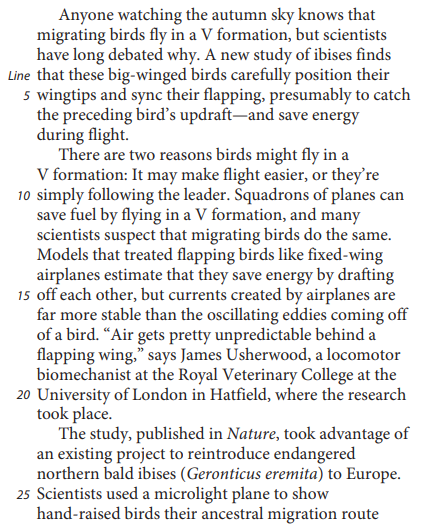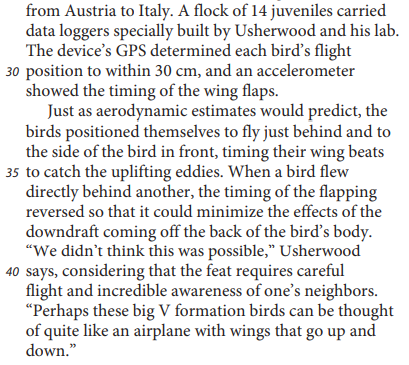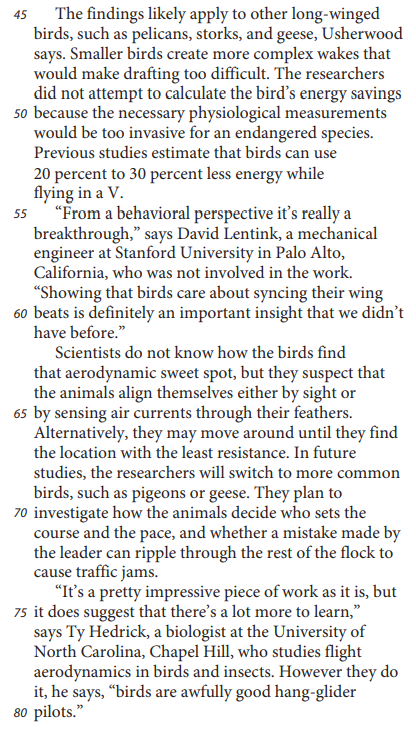SAT (Scholastic Assessment Test) is a standard test, used for taking admission to undergraduate programs of universities or colleges of the United States. SAT is developed and published by the College Board, an organization in the United States, administered by the Educational Testing Service. In this article of AKVTutorials, you will get SAT Reading Section Practice Test 33 | SAT 2024 Online Tutor AMBiPi.
This passage is adapted from Patricia Waldron, “Why Birds Fly in a V Formation.” ©2014 by American Association for the Advancement of Science.



SAT Reading Comprehension Practice Test Questions
SAT Practice Test 33 Question No 1
The main purpose of the passage is to
Option A: describe how squadrons of planes can save fuel by flying in a V formation.
Option B: discuss the effects of downdrafts on birds and airplanes.
Option C: explain research conducted to study why some birds fly in a V formation.
Option D: illustrate how birds sense air currents through their feathers.
SAT Practice Test 33 Answer No 1
Show/Hide Answer
Option C :
The main purpose of the passage is conveyed by the first sentence: “Anyone watching the autumn sky knows that migrating birds fly in a V formation, but scientists have long debated why.” The first paragraph continues by focusing on new research that might answer the question of why birds fly in that formation (“presumably to catch the preceding bird’s updraft — and save energy during flight”). As a whole, the passage can therefore be seen as a discussion of the biological motivation behind migrating birds’ reliance on the V formation.
Choice A is incorrect because the squadrons of planes mentioned in the second paragraph are used as an example to discuss migrating birds but are not themselves the main subject of this passage. Choice B is incorrect because although the fourth paragraph does discuss the role of downdrafts in V-formation flight, this discussion is brief and does not constitute the main purpose. Choice D is incorrect because the passage does not illustrate how birds sense air currents through their feathers; instead, the seventh paragraph suggests in passing that such sensation may play a role in maintaining the V formation: “Scientists do not know how the birds find that aerodynamic sweet spot, but they suspect that the animals align themselves either by sight or by sensing air currents through their feathers.”
SAT Practice Test 33 Question No 2
The author includes the quotation “Air gets pretty unpredictable behind a flapping wing” (lines 17-18) to
Option A: explain that the current created by a bird differs from that of an airplane.
Option B: stress the amount of control exerted by birds flying in a V formation.
Option C: indicate that wind movement is continuously changing.
Option D: emphasize that the flapping of a bird’s wings is powerful.
SAT Practice Test 33 Answer No 2
Show/Hide Answer
Option A :
In the second paragraph of the passage, the quotation “Air gets pretty unpredictable behind a flapping wing” immediately follows the statement that “currents created by airplanes are far more stable than the oscillating eddies coming off of a bird.” The inclusion of the above quotation can therefore be seen as a way to explain that the current created by a bird’s flapping wings are different from the current coming off the fixed wing of an airplane.
Choice B is incorrect because the quotation’s explanation that air is “unpredictable” behind a bird’s wing stresses the bird’s lack of control over the air current. Choice C is incorrect because the quotation attributes the unpredictability of the current “behind a flapping wind” to the action of the wing rather than to wind, and in fact, the passage makes no mention of wind. Choice D is incorrect because the quotation characterizes the flapping of the bird’s wings in terms of the unpredictability of its effects, not of its comparative strength.
SAT Practice Test 33 Question No 3
What can reasonably be inferred about the reason Usherwood used northern bald ibises as the subjects of his study?
Option A: The ibises were well acquainted with their migration route.
Option B: Usherwood knew the ibises were familiar with carrying data loggers during migration.
Option C: The ibises have a body design that is similar to that of a modern airplane.
Option D: The ibises were easily accessible for Usherwood and his team to track and observe.
SAT Practice Test 33 Answer No 3
Show/Hide Answer
Option D :
The reason Usherwood used northern bald ibises as the subjects of his study is clearly stated at the beginning of the third paragraph: “The study, published in Nature, took advantage of an existing project to reintroduce endangered northern bald ibises (Geronticus eremita) to Europe.” Because the project reintroducing those birds was already underway, it was therefore easy for Usherwood and his team to join it.
Choice A is incorrect because it would not be accurate to say that ibises were well acquainted with their migration route, as the third paragraph explains that scientists needed to “show hand-raised birds their ancestral migration route.” Choice B is incorrect because the third paragraph states that the ibises wore “data loggers specially built by Usherwood and his lab” but never indicates that they had worn any such device before or undertaken migration previously. Choice C is incorrect because the passage never claims that ibises’ body shape is similar to the design of a modern airplane, instead of comparing only a V formation of birds to an airplane in the fourth paragraph.
SAT Practice Test 33 Question No 4
Which choice provides the best evidence for the answer to the previous question?
Option A: Lines 3-7 (“A new . . . flight”)
Option B: Lines 10-12 (“Squadrons… same”)
Option C: Lines 22-24 (“The study… Europe”)
Option D: Lines 29-31 (“The device’s… flaps”)
SAT Practice Test 33 Answer No 4
Show/Hide Answer
Option C :
The previous question asks why Usherwood used northern bald ibises as the subject of his study. The answer, that he had easy access to them because they were being used in another scientific study, is supported at the beginning of the passage’s third paragraph: “The study, published in Nature, took advantage of an existing project to reintroduce endangered northern bald ibises (Geronticus eremita) to Europe.”
Choices A, B, and D are incorrect because the lines cited do not support the answer to the previous question as to why Usherwood chose northern bald ibises as the subject of his study; instead, they describe the results of the study (choice A), compare birds and planes in flight (choice B), and describe one element of the actual study (choice D) but not the reason ibises were chosen.
SAT Practice Test 33 Question No 5
What is the most likely reason the author includes the 30 cm measurement in line 30?
Option A: To demonstrate the accuracy with which the data loggers collected the data
Option B: To present recorded data about how far an ibis flies between successive wing flaps
Option C: To provide the wingspan length of a juvenile ibis
Option D: To show how far behind the microlight plane each ibis flew
SAT Practice Test 33 Answer No 5
Show/Hide Answer
Option A :
At the end of the third paragraph, the author notes that the GPS tracking devices attached to the birds “determined each bird’s flight position to within 30 cm.” This detail, along with the author’s mention in the same sentence of another device that measured the timing of the wing flaps, provides evidence for the inference that the author likely specified 30 cm to underscore Usherwood’s use of precise data-collection methods.
Choice B is incorrect because the passage does not state that the distance an ibis flies between wing flaps was something that could be ascertained by Usherwood’s study. Choice C is incorrect because the passage does not discuss the wingspan length of juvenile ibises or suggest that this length could be determined from Usherwood’s tracking data. Choice D is incorrect because the passage does not discuss the distance maintained between the plane and the ibises in flight.
SAT Practice Test 33 Question No 6
What does the author imply about pelicans, storks, and geese flying in a V formation?
Option A: They communicate with each other in the same way as do ibises.
Option B: They have the same migration routes as those of ibises.
Option C: They create a similar wake to that of ibises.
Option D: They expend more energy than do ibises.
SAT Practice Test 33 Answer No 6
Show/Hide Answer
Option C :
At the beginning of the fifth paragraph the passage states that “the findings likely apply to other long-winged birds, such as pelicans, storks, and geese, Usherwood says. Smaller birds create more complex wakes that would make drafting too difficult.” In these lines, the author therefore implies that, unlike smaller birds, pelicans, storks, and geese flying in a V formation likely create a similar wake to that of ibises.
Choice A is incorrect because the passage focuses entirely on bird flight, not bird communication. Choices B and D are incorrect because the passage discusses pelicans, storks, and geese only with respect to their drafting behavior, not in terms of their migration routes or how much energy they might expend when flying.
SAT Practice Test 33 Question No 7
Which choice provides the best evidence for the answer to the previous question?
Option A: Lines 35-38 (“When… body”)
Option B: Lines 47-48 (“Smaller… difficult”)
Option C: Lines 52-54 (“Previous…aV”)
Option D: Lines 66-67 (“Alternatively… resistance”)
SAT Practice Test 33 Answer No 7
Show/Hide Answer
Option B :
The previous question asks what the author implies about pelicans, storks, and geese flying in a V formation. The answer, that they produce a similar wake to ibises, is supported at the beginning of the fifth paragraph: “Smaller birds create more complex wakes that would make drafting too difficult.” This sentence, in conjunction with the preceding sentence’s assertion of the probable applicability of Usherwood’s findings to pelicans, storks, and geese, underscores that the point of probable similarity between ibises and those other species are in their wake and the drafting it makes possible.
Choices A, C, and D are incorrect because the lines cited do not support the answer to the previous question regarding what the author implies about pelicans, storks, and geese flying in a V formation. Instead, they explain one finding in the ibis study, with no reference to other long-winged species (choice A); highlight the findings of a previous study of energy use in bird flight, with no reference to the relationship between ibises and other species (choice C); and offer a theory about ibises in flight, again with no reference to other species (choice D).
SAT Practice Test 33 Question No 8
What is the main idea of the seventh paragraph (lines 62-73)?
Option A: Different types of hierarchies exist in each flock of birds.
Option B: Mistakes can happen when long-winged birds create a V formation.
Option C: Future research will help scientists to better understand V formations.
Option D: Long-winged birds watch the lead bird closely to keep a V formation intact.
SAT Practice Test 33 Answer No 8
Show/Hide Answer
Option C :
The seventh paragraph speculates that further research may provide insight into how and why birds fly in formation: “In future studies, the researchers will switch to more common birds, such as pigeons or geese. They plan to investigate how the animals decide who sets the course and the pace.” In sum, the seventh paragraph can therefore be seen as recognizing that more research is needed to explain the phenomenon of flight formation more completely.
Choice A is incorrect because neither the seventh paragraph nor the passage as a whole is concerned with bird hierarchies; the decision as to which bird sets the “course” or “pace” is mentioned only as another aspect of bird flight that scientists have yet to explain fully. Choice B is incorrect because the seventh paragraph only briefly mentions mistakes in V-formation flight, and this subject is not a central focus of the paragraph. Choice D is incorrect because although the seventh paragraph mentions the sighting of a lead bird or “leader” as a possible factor in the V formation, this factor is mentioned briefly and in conjunction with other factors so that to describe it as the main idea would misrepresent the paragraph as a whole.
SAT Practice Test 33 Question No 9
The author uses the phrase “aerodynamic sweet spot” in line 63 most likely to
Option A: describe how the proper structural design of an airplane helps to save fuel.
Option B: show that flying can be an exhilarating experience.
Option C: describe the birds’ synchronized wing movement.
Option D: suggest that a certain position in a V formation has the least amount of wind resistance.
SAT Practice Test 33 Answer No 9
Show/Hide Answer
Option D :
In describing the way that long-winged birds like ibises fly in a V formation by drafting off each other, the seventh paragraph begins by stating, “scientists do not know how the birds find that aerodynamic sweet spot.” In context, the phrase “aerodynamic sweet spot” characterizes the particular spatial relationship among birds in the formation that affords the least amount of wind resistance and is thus beneficial for flock members to maintain.
Choice A is incorrect because the author uses the phrase “aerodynamic sweet spot” concerning bird flight, not plane flight. Choice B is incorrect because the phrase is not meant to imply the joy of flight so much as the optimum efficiency that can be found by flying in a certain position. Choice C is incorrect because the phrase is not used to discuss synchronized wing movement among birds, nor is synchronization addressed anywhere in the seventh paragraph.
SAT Practice Test 33 Question No 10
As used in line 72, “ripple” most nearly means
Option A: fluctuate.
Option B: spread.
Option C: wave.
Option D: undulate.
SAT Practice Test 33 Answer No 10
Show/Hide Answer
Option B :
In the seventh paragraph, the passage explains that one aspect of bird flight that awaits further study by scientists is the question of whether “a mistake made by the leader can ripple through the rest of the flock to cause traffic jams.” In this context, to say that a mistake might “ripple” through the flock most nearly means that it might progressively spread through the flock.
Choices A, C, and D are incorrect because in the context of the seventh paragraph, to “ripple” through the flock means to spread through it progressively, not to fluctuate (choice A), to wave, or move in the pattern of the ebb and flow of waves (choice C), or to undulate, or move in a manner that creates a textured, undulating appearance (choice D).



